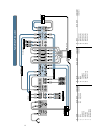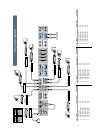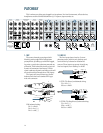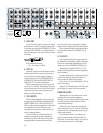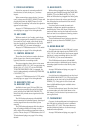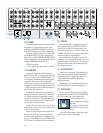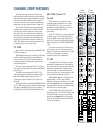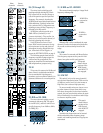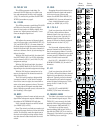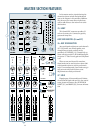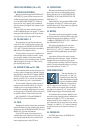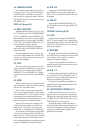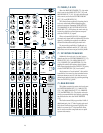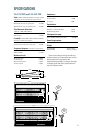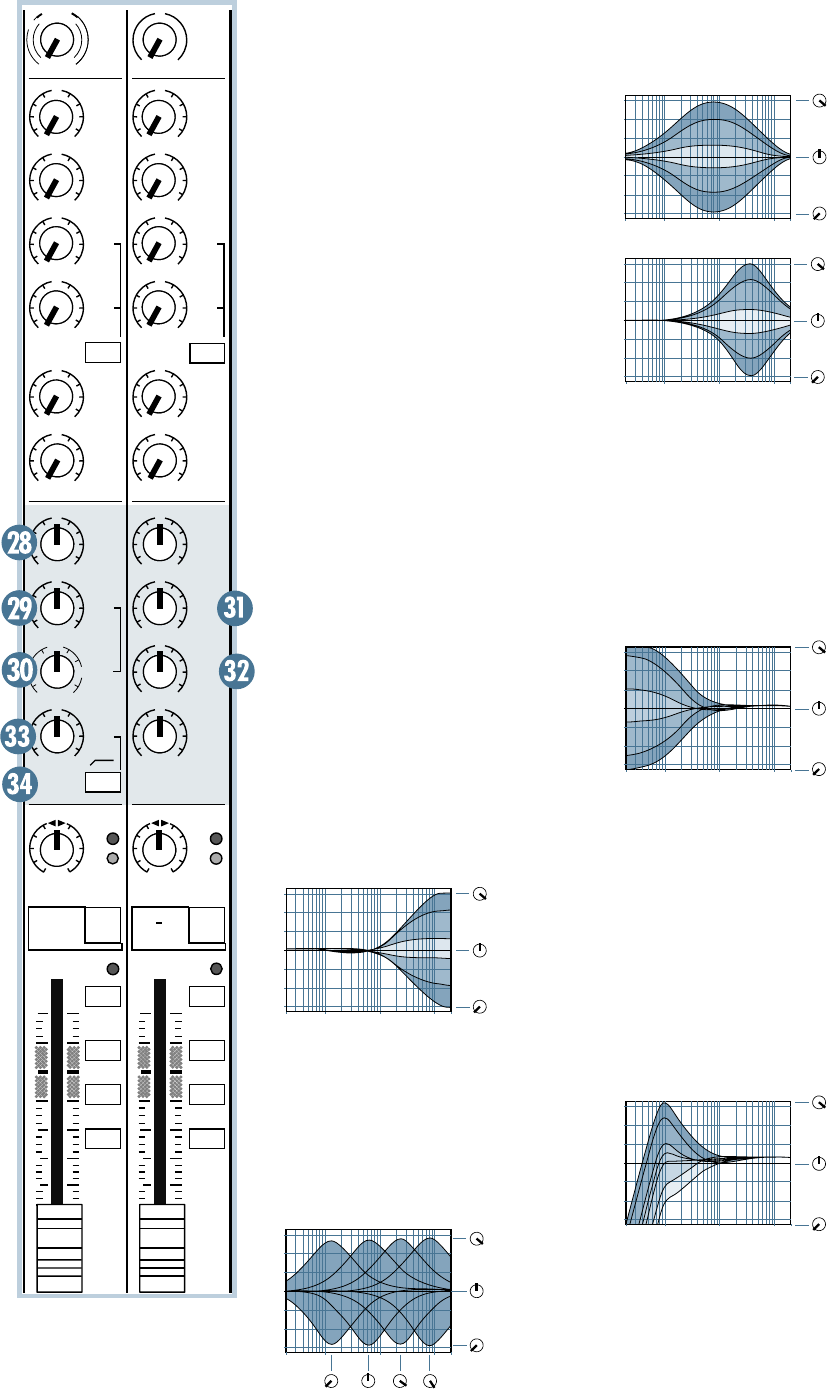
20
EQ: (28 through 34)
The mixer has low shelving, mid
peaking and high shelving EQ. “Shelv-
ing” means that the circuitry boosts or
cuts all frequencies past the specified
frequency. For example, boosting the
LOW EQ knob boosts bass frequencies at
80Hz and below. “Peaking” means that
only a selected “hill” of frequencies sur-
rounding a center “hilltop” frequency is
affected by the EQ control.
All EQ gain controls provide up to
15dB of boost (clockwise) or cut
(counter-clockwise). They are flat (no
boost or cut) at their center detents, ef-
fectively bypassing their circuits.
Note: EQ boost is a form of level
boost. With excessive amounts, the sig-
nal may become too hot and overload
subsequent circuitry. Should this hap-
pen, either back off the EQ gain, or
repeat the SET THE LEVELS on page 8.
The following graphs show how the
frequency response changes when the
various controls are adjusted.(The
graphs are simplified for entertainment
and enlightenment purposes only).
28. HI
This control is centered at 12kHz and
above. Boost it to add sizzle and defini-
tion to sounds with high-frequency
transients, such as cymbals. Reduce it to
attenuate sibilance or to mask tape hiss.
29. MID and 30. FREQ
The mono channels employ a semi-
parametric mid-sweep EQ. The gain is
set via MID (29), and then “aimed” at a
specific frequency, from 100Hz to 8kHz,
via FREQ (30).
31. HI MID and 32. LOW MID
The stereo channels employ a 2-stage fixed-
frequency midrange EQ:
LOW MID is
centered at
800Hz.
HI MID is
centered at
3kHz
Midrange EQ is often considered the most
dynamic, because the frequencies that define
any sound are almost always found in this
range.
33. LOW
This control is centered at 80Hz and below.
This frequency represents the punch in kick
drums, bass guitar and fat synth patches.
This graph
shows various
settings of the
LOW control,
with LOW CUT
not engaged.
34. LOW CUT
This switch (only on the mono channels)
cuts the bass frequencies below 75Hz at a rate
of 18dB per octave. Low Cut is also known as
High Pass (low cut dress=high pass rate).
To prevent muddy mixes, use low cut on ev-
ery mono channel except those which carry
kick drum, bass guitar or other bass-intensive
sounds. Low cut can also help reduce the possi-
bility of feedback in live situations and it helps
to conserve amplifier power.
This graph
shows various
settings of the
LOW control,
with LOW CUT
engaged.
Desirable low frequencies can be boosted
whilst undesirable lower frequency stage
rumble, mic handling clunks and P-p-pops are
attenuated.
dB
30
20
10
OO
40
50
5
5
U
60
10
dB
30
20
10
OO
40
50
5
5
U
60
10
LR LR
U
OO
+15
U
OO
+15
U
OO
+15
U
OO
+15
U
+15-15
U
+15-15
U
+15-15
U
+15-15
U
+15-15
U
+15-15
U
+15-15
U
OO
+15
U
OO
+15
U
OO
+15
U
OO
+15
U
OO
+15
U
OO
+15
U
OO
+15
U
OO
+15
-
20 +20
U
POST POST
POST
POST
+15dB
-
45dB
M
I
C
G
A
I
N
0
U
60
-
1
0
d
B
V
600
1.5k150
8k10 0
12k
HI
3k
MID
HI
800Hz
MID
LOW
EQ
LOW CUT
75 Hz
18dB/OCT
80Hz
LOW
80Hz
LOW
3
-
4
L
-
R
1
-
2
3
-
4
L
-
R
1
-
2
-20
OL
-20
OL
PRE
1
PRE
PRE
2
3
5
6
12k
HI
MID
FREQ
TRIM
20
TRIM
21
22
AUX
PRE
1
PRE
PRE
2
3
5
6
AUX
20
MUTE
EQ
21 22
MUTE
SOLO
SOLO
PAN PAN
44
MUTE /
SOLO
MUTE /
SOLO
MUTE /
SOLO
MUTE /
SOLO
20Hz 100Hz 1kHz 10kHz 20kHz
–15
–10
–5
0
+5
+10
+15
LOW MID
20
Hz
100
Hz
1k
Hz
10k
Hz
20k
Hz
–15
–10
–5
0
+5
+10
+15
HI MID
20Hz 100Hz 1kHz 10kHz 20kHz
–15
–10
–5
0
+5
+10
+15
HI
20
Hz
100
Hz
1k
Hz
10k
Hz
20k
Hz
–15
–10
–5
0
+5
+10
+15
MID
FREQ
20
Hz
100
Hz
1k
Hz
10k
Hz
20k
Hz
–15
–10
–5
0
+5
+10
+15
LO
W
20
Hz
100
Hz
1k
Hz
10k
Hz
20k
Hz
–15
–10
–5
0
+5
+10
+15
LOW
Mono
channels
Stereo
channels



